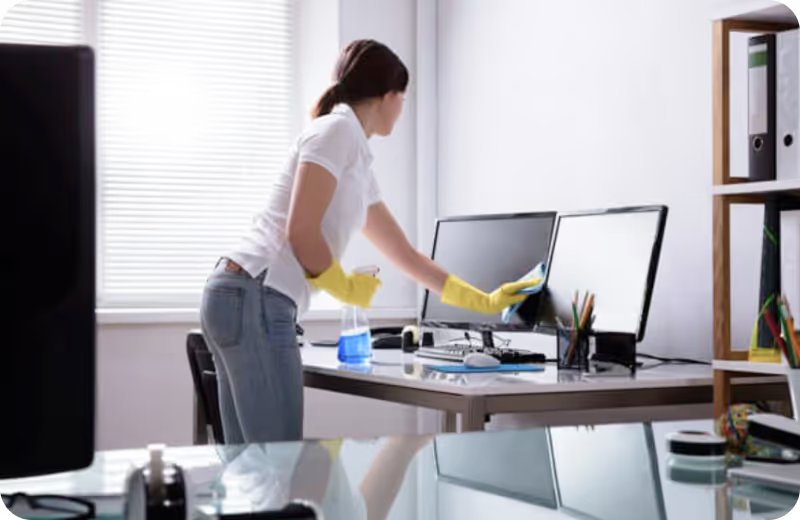
We’ve tackled cleaning the toilet, getting rid of rings, and even sought whether Coca-cola really cleans toilets or not. But what about the supplies that do the cleaning? Toilet plungers and toilet brushes work the filthiest of jobs, and are therefore some of the dirtiest implements that you will find in your home.
Both the plunger and the brush are capable of harbouring disease-causing bacteria that can spread to any surface they come in contact with, and when your kid or family member gets a hold of these surfaces, they can get sick from the bacteria left behind by the plunger and the brush.
Cleaning these implements is one thing, but disinfecting them is the key to keeping your bathroom clean. In this guide, we’ll present the ways you can clean your plunger and brush using only a few household ingredients.
How to Clean A Toilet Plunger
More than just a slapstick comedy prop, the toilet plunger was invented to fix issues in our modern day plumbing systems, unclogging toilets since the late 1700s. Made to create enough pressure to flush a toilet, a toilet plunger is helpful in times of emergency clogs and defective units.
The toilet plunger gets right into the toilet bowl, and so it takes on whatever bacteria and dirt is on the toilet. Bacteria like E. Coli and Salmonella, which can cause moderate to serious illnesses, can reside on the plunger, and spread to wherever we store our toilet plunger. Thankfully, cleaning a toilet plunger is a simple two step process using chlorine bleach.
How to Clean Plunger with Chlorine Bleach
Chlorine bleach is a powerful disinfectant cleaner known for its whitening properties, and strong smell. If you have sensitive skin, best to use gloves and wear a mask when handling chlorine bleach as the substance can cause bleach burns, allergic reactions, and respiratory problems when in contact with skin or lung tissue.
Open some ventilation like windows, doors, and an exhaust fan to begin working with chlorine bleach. Place a cup of bleach into the bowl of your cleaned toilet, and place the plunger inside. Swirl the toilet plunger to mix the water and the bleach solution, and let it sit for around 5-10 minutes. Flush the toilet, and rinse your toilet plunger in clean water. Allow to air dry.
In this method, you can clean both the toilet and the toilet plunger in one go. Bleach, however, can be irritating to the skin, so best to wipe dry the seat and rim of the toilet afterwards to prevent bleach burns on the next person using the toilet.
How to Clean A Toilet Brush
Toilet brushes do the cleaning, but are very rarely cleaned themselves other than the occasional rinse. Yet, we keep these brushes in our homes, left to be exposed to bacteria, germs, and viruses that can spread onto different areas in the bathroom. Each time we use the toilet brush to clean the toilet bowl, the germs are passed around from surface to surface.
Doing a quick clean of a toilet brush is an improvement in our overall hygiene, and makes toilet bowl cleaning much more sanitary as well. Clean a toilet brush using your regular toilet cleaner, and a little spritz of hydrogen peroxide or vinegar to disinfect. Hot water can also be used on non-nylon and heat resistant brushes for maximum cleanliness.
How to Clean A Toilet Brush with Hydrogen Peroxide
Similarly to cleaning a toilet plunger, you can clean a toilet brush and your toilet at the same time using the same cleaning supplies. The same commercial or DIY all-purpose cleaner that you use to clean your toilet can be used to clean your brush in the same manner. Simply add the usual amount of toilet cleaner to your toilet, and swirl the liquid around using the brush.
Leave the brush in the toilet cleaner solution for 5-10 minutes, and flush the toilet. Rinse the toilet brush in hot water, completely removing any residue of toilet cleaner to ensure that the solution does not react with hydrogen peroxide.
Place the brush between the rim and toilet seat, and allow the brush to drip off excess water. Place hydrogen peroxide and water into a spray bottle, and give the brush a little spritz of the disinfectant spray. Spray the same disinfecting solution onto the toilet brush holder to clean the vessel, before placing the brush back into the holder.
How to Clean A Toilet Brush with Vinegar
Distilled white vinegar is a suitable substitute for disinfectant sprays and cleaners in a pinch. Although vinegar may leave an off-putting smell, it is an effective deterrent for mold and mildew. To clean your brush with vinegar, place a cup or two of distilled white vinegar into the bowl of your toilet and swirl the toilet brush inside.
After 10 minutes, remove the brush and give it a little spray of vinegar from a spray bottle. Flush the toilet, and rinse the brush in clean water to remove any vinegar residue. Clean the holder using the vinegar spray, and let it dry. Place the brush back onto its holder after it has fully dried.
Doing More with Less
Cleaning toilet implements doesn’t take much more time than cleaning a toilet, and you can do both and still keep up with the same cleaning routine. The next time you decide to clean your toilet, think about cleaning your plunger, and brush as well to optimize the power of your cleaning solutions, as well as ensuring you’re doing a thorough cleaning job.
With most of our cleaning schedules, we primarily focus on cleaning the ‘important’ parts of the home - mostly the visible and often used furniture and fixtures. We tend to forget that the implements that do the cleaning will need cleaning too, and does not even require any extra steps in cleaning.
For more cleaning hacks, visit our blog. Find cleaning a hassle? Hire a part-time maid for cleaning your home to enjoy a clean house at the convenience of professional cleaning services made available by Luce!


























